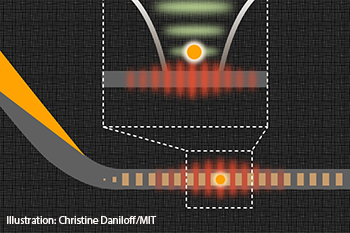
Trapping rubidium atoms in a lattice of light could help the development of quantum computing.
Researchers at Harvard University and Massachusetts Institute of Technology (both Cambridge, Mass., U.S.A.) have managed to couple isolated, trapped single atoms with guided laser light to make a quantum light switch that may help pave the path toward quantum networks. Integrated quantum circuits for long-distance quantum communications require such quantum optical switches, but have been difficult to create because photons and atoms don’t interact strongly. MIT's Vladan Vuletić and Harvard's Mikhail Lukin have revealed a promising approach using cavity quantum electrodynamics (DOI: 10.1038/nature13188).
The approach involves a single rubidium atom confined in a one-sided nanoscale photonic crystal cavity attached to a tapered optical fiber input and output. Atoms are trapped in close proximity to an incident photon—within a volume measuring about 0.4 λ3, which is less than the scale of the optical wavelength of photons. The distance is so close, while also being sufficiently close to the surface of the cavity (100 to 200 nm), that it causes the phase of the photon to change by the value of π.
Said Vuletić, “Perhaps the biggest challenge was holding the atom away from the nanoscale device at a stable distance a hundred times thinner than a human hair without it being pulled in by surface forces.” The stability was achieved via a tapered fiber waveguide interface that provides adiabatic coupling of the fiber mode to the waveguide mode.
The nanoscale device could be used to couple different atoms together. Not only can the photon change the phase of the atom, the atom can change the polarization state of the photon. The change in phase works like a switch, say the researchers, and it’s easier to control than some other methods are. Another promising technique involves superconducting qubits, which require complex cooling systems to eliminate thermal noise and are difficult to scale up.
Several atoms could be placed in a lattice arrangement to scale up the quantum processing capability in a space only a few hundred nanometers thick.
The researchers also found that the new device serves as a kind of router that separates photons from each other.
